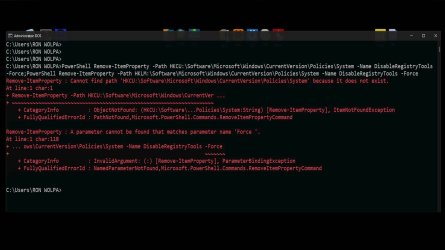This tutorial will show you how to enable or disable Registry Editor (regedit.exe) and REG files for all or specific users in Windows 10 and Windows 11.
System configuration information is stored centrally in a hierarchical database called the registry. You can use Registry Editor to add and edit registry keys and values, restore the registry from a backup or to default values, and to import or export keys for reference or backup.
References:

About the Registry - Win32 apps
The following topics describe the registry and the functions you can call to retrieve and modify the data stored there.
learn.microsoft.com

Registry Editor
learn.microsoft.com

Windows registry for advanced users - Windows Server
Describes the Windows registry and provides information about how to edit it.
learn.microsoft.com
You must be signed in as an administrator to enable or disable Registry Editor.
Contents
- Option One: Enable or Disable Registry Editor for All or Specific Users in Local Group Policy Editor
- Option Two: Enable or Disable Registry Editor for All Users using Command
EXAMPLE: Registry Editor disabled
The Local Group Policy Editor is only available in the Windows 10/11 Pro, Enterprise, and Education editions.
All editions can use Option Two to configure the same policy.
1 Open the all users, specific users or groups, or all users except administrators Local Group Policy Editor for how you want this policy applied.
2 Navigate to the policy location below in the left pane of the Local Group Policy Editor. (see screenshot below)
User Configuration > Administrative Templates > System
3 In the right pane of System in the Local Group Policy Editor, double click/tap on the Prevent access to registry editing tools policy to edit it. (see screenshot above)
4 Do step 5 (enable) or step 6 (disable) below for what you want.
5 Enable Registry Editor
This is the default setting.
A) Select (dot) Not Configured. (see screenshot below)
B) Click/tap on OK, and go to step 7.
6 Disable Registry Editor
A) Select (dot) Enabled. (see screenshot below)
B) Select Yes in the "Disable regedit from running silently?" drop menu.
C) Click/tap on OK, and go to step 7.
7 You can now close the Local Group Policy Editor if you like.
1 Open Windows Terminal (Admin), and select Command Prompt.
2 Copy and paste the command below you want to use into Windows Terminal (Admin), and press Enter. (see screenshots below)
Enable Registry Editor
This is the default setting.
PowerShell Remove-ItemProperty -Path HKCU:\Software\Microsoft\Windows\CurrentVersion\Policies\System -Name DisableRegistryTools -Force -ErrorAction SilentlyContinue; PowerShell Remove-ItemProperty -Path HKLM:\Software\Microsoft\Windows\CurrentVersion\Policies\System -Name DisableRegistryTools -Force -ErrorAction SilentlyContinueOR
Disable Registry Editor
PowerShell $P = ':\Software\Microsoft\Windows\CurrentVersion\Policies\System'; $U = 'HKCU'+$P; if (-not (Test-Path $U)) { New-Item -Path $U -Force }; Set-ItemProperty -Path $U -Name DisableRegistryTools -Value 2 -Force; $M = 'HKLM'+$P; if (-not (Test-Path $M)) { New-Item -Path $M -Force }; Set-ItemProperty -Path $M -Name DisableRegistryTools -Value 2 -Force3 You can now close Windows Terminal (Admin) if you like.
That's it,
Shawn Brink
Last edited:
















